
Shaddam IV of House Corrino is a fictional character in the Dune universe created by Frank Herbert. He is Padishah Emperor of the Known Universe in Herbert's 1965 novel Dune. Shaddam's accession to the throne is chronicled in the Prelude to Dune prequel trilogy (1999-2001) by Brian Herbert and Kevin J. Anderson, and he later appears in the prequel series Heroes of Dune (2008–2009).
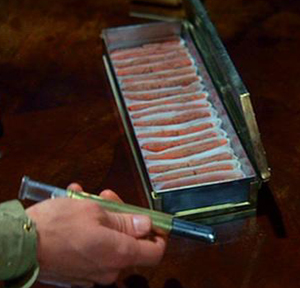
Melange, often referred to as simply "the spice", is the name of the fictional drug central to the Dune series of science fiction novels by Frank Herbert, and derivative works.

The Spacing Guild is an organization in Frank Herbert's science fiction Dune universe. With its monopoly on interstellar travel and banking, the power of the Guild is balanced against that of the Padishah Emperor as well as of the assembled noble Houses of the Landsraad. Mutated Guild Navigators use the spice drug melange to successfully navigate "folded space" and safely guide enormous heighliner starships from planet to planet instantaneously. Essentially apolitical, the Guild is primarily concerned with the flow of commerce and preservation of the economy that supports them; although their ability to dictate the terms of and fees for all transport gives them influence in the political arena, they do not pursue political goals beyond their economic ones. It is noted in Dune (1965) that Houses of the Imperium may contract with the Guild to be removed "to a place of safety outside the System"; in the past, some Houses in danger of ruin or defeat have "become renegade Houses, taking family atomics and shields and fleeing beyond the Imperium". The Guild controls a "sanctuary planet" known as Tupile intended for such "defeated Houses of the Imperium ... Location(s) known only to the Guild and maintained inviolate under the Guild Peace".

House Atreides is a fictional noble family from the Dune universe created by Frank Herbert. One of the Great Houses of the feudal interstellar empire known as the Padishah Empire, its members play a role in every novel in the series. It is suggested within the series that the root of the Atreides line is the mythological Greek House of Atreus. In Homer's Iliad, the brothers Agamemnon and Menelaus are dubbed "the Atreides", meaning "the sons of Atreus".

House Harkonnen is a powerful noble family in Frank Herbert's fictional Dune universe. The Harkonnens are featured prominently in the original 1965 novel Dune, and are also a major presence in both the Prelude to Dune (1999-2001) and Legends of Dune (2002-2004) prequel trilogies by Brian Herbert and Kevin J. Anderson. The Harkonnen bloodline itself extends throughout all of the original Dune novels.
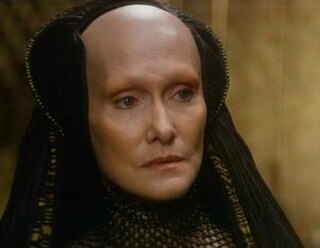
Gaius Helen Mohiam is a fictional character in the Dune universe created by Frank Herbert. She is a Bene Gesserit Reverend Mother, and initially appears in the 1965 novel Dune and its 1969 sequel, Dune Messiah. Mohiam also has a major role in the Prelude to Dune prequel trilogy (1999–2001) by Brian Herbert and Kevin J. Anderson.

Princess Irulan is a fictional character and member of House Corrino in the Dune universe created by Frank Herbert. She first appears in Dune (1965), and is later featured in Dune Messiah (1969) and Children of Dune (1976). The character's birth and early childhood are touched upon in the Prelude to Dune prequel trilogy (1999–2001) by Brian Herbert and Kevin J. Anderson, and she is a principal character in the Herbert/Anderson series Heroes of Dune (2008–2009). Irulan has also appeared in all film and television adaptations of Herbert's Dune works.
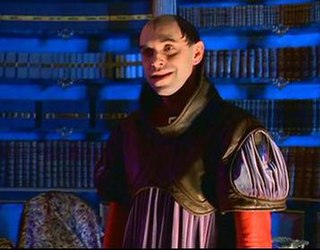
Count Hasimir Fenring is a fictional character in the Dune universe created by Frank Herbert. He is featured in the 1965 science fiction novel Dune by Frank Herbert, and is also a key character in the Prelude to Dune trilogy by Brian Herbert and Kevin J. Anderson. He later appears in the 2008 novel Paul of Dune.

Dune is a science fiction media franchise that originated with the 1965 novel Dune by Frank Herbert and has continued to add new publications up to 2017. Dune is frequently cited as the best-selling science fiction novel in history. It won the 1966 Hugo Award and the inaugural Nebula Award for Best Novel, and was later adapted into a 1984 film and a 2000 television miniseries. Herbert wrote five sequels, and the first two were presented as a miniseries in 2003. The Dune universe has also inspired some traditional games and a series of video games. Since 2009, the names of planets from the Dune novels have been adopted for the real-world nomenclature of plains and other features on Saturn's moon Titan.

Dune: House Atreides is a 1999 science fiction novel by Brian Herbert and Kevin J. Anderson, set in the fictional Dune universe created by Frank Herbert. It is the first book in the Prelude to Dune prequel trilogy, which takes place before the events of Frank Herbert's celebrated 1965 novel Dune. Bantam Books made a $3 million deal for the novels in 1997. The Prelude to Dune novels draw from notes left behind by Frank Herbert after his death.

A series of Duneshort stories have been written that relate to the Dune novels by Frank Herbert, Brian Herbert and Kevin J. Anderson. Some of these stories were originally available for download from the official Dune website, released in a promotional capacity in conjunction with the Brian Herbert/Kevin J. Anderson novels. "Dune: A Whisper of Caladan Seas'," "Dune: Hunting Harkonnens," "Dune: Whipping Mek" and "Dune: The Faces of a Martyr" were later published as part of the collection The Road to Dune released in September 2005. "Dune: Sea Child" was published in Elemental, a 2006 benefit anthology for children who survived the 2004 Indian Ocean tsunami, and was later made available as part of the paperback edition of The Road to Dune. "Dune: Treasure in the Sand" was published online in 2006 at Jim Baen's Universe, and was later made available as part of the paperback edition of Hunters of Dune. "Dune: Wedding Silk" was released June 12, 2011 in the Dune e-book short story collection Tales of Dune, which also included previously published stories "Dune: Sea Child" and "Dune: Treasure in the Sand." "Dune: Red Plague" was released on November 1, 2016, followed by "Dune: The Waters of Kanly" in the short story collection Infinite Stars on October 17, 2017.

Margot, Lady Fenring is a fictional character from the Dune universe created by Frank Herbert. She is featured in Herbert's Dune (1965), and is a major character in the Prelude to Dune prequel trilogy (1999–2001) by Brian Herbert and Kevin J. Anderson and the 2008 novel Paul of Dune.
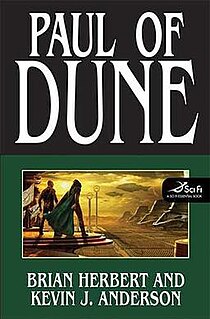
Paul of Dune is a 2008 science fiction novel written by Brian Herbert and Kevin J. Anderson, set in the Dune universe created by Frank Herbert. Released on September 16, 2008, it is the first book in the Heroes of Dune series and chronicles events between Frank Herbert's Dune (1965) and Dune Messiah (1969), as well as between Dune and its 2001 Brian Herbert/Kevin J. Anderson prequel, Dune: House Corrino.

Sisterhood of Dune is a 2012 science fiction novel by Brian Herbert and Kevin J. Anderson, set in the Dune universe created by Frank Herbert. It is the first book in their Great Schools of Dune prequel trilogy, which itself is a sequel to their Legends of Dune trilogy. The book is set eighty years after the events of 2004's Dune: The Battle of Corrin, in which the human military finally defeat the thinking machine armies of Omnius. Now, the fledgling Bene Gesserit, Mentat and Suk Schools, as well as the Spacing Guild, are threatened by the independent anti-technology forces gaining power in the aftermath of the Butlerian Jihad. The Great Schools of Dune trilogy, first mentioned by Anderson in a 2010 blog post, will chronicle the early years of these organizations, which figure prominently in the original Dune novels.
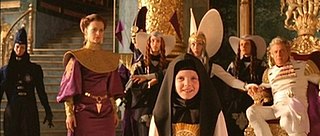
Multiple organizations of the Dune universe dominate the political, religious, and social arena of the fictional setting of Frank Herbert's Dune series of science fiction novels, and derivative works. Set tens of thousands of years in the future, the saga chronicles a civilization which has banned computers but has also developed advanced technology and mental and physical abilities through physical training, eugenics and the use of the drug melange. Specialized groups of individuals have aligned themselves in organizations focusing on specific abilities, technology and goals. Herbert's concepts of human evolution and technology have been analyzed and deconstructed in at least one book, The Science of Dune (2008). His originating 1965 novel Dune is popularly considered one of the greatest science fiction novels of all time, and is frequently cited as the best-selling science fiction novel in history. Dune and its five sequels by Herbert explore the complex and multilayered interactions of politics, religion, ecology and technology, among other themes.

The Dune prequel series is a sequence of novel trilogies written by Brian Herbert and Kevin J. Anderson. Set in the Dune universe created by Frank Herbert, the novels take place in various time periods before and in between Herbert's original six novels, which began with 1965's Dune. In 1997, Bantam Books made a $3 million deal with the authors for three Dune prequel novels, partially based upon notes left behind by Frank Herbert, that would come to be known as the Prelude to Dune trilogy. Starting with 1999's Dune: House Atreides, the duo have published 11 Dune prequel novels to date. In 2011 Publishers Weekly called the series "a sprawling edifice that Frank Herbert’s son and Anderson have built on the foundation of the original Dune novels." Jon Michaud of The New Yorker wrote in 2013, "The conversion of Dune into a franchise, while pleasing readers and earning royalties for the Herbert estate, has gone a long way toward obscuring the power of the original novel."

















